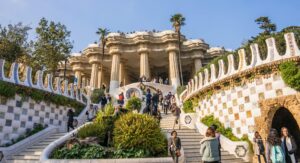- Pompeii was a thriving city: Pompeii was a bustling city with a population of around 11,000 people. It was a major center for trade and commerce in ancient Rome.
- Pompeii was not completely destroyed by lava: The eruption of Mount Vesuvius in 79 AD did not completely destroy Pompeii. Rather, the city was buried under a thick layer of volcanic ash and pumice, which preserved many of the buildings and artifacts for centuries.
- Pompeii was rediscovered by accident: The city was buried for centuries and forgotten until it was rediscovered by accident in 1748 by a group of explorers who were digging a well.
- Pompeii had a red-light district: Pompeii had a neighbourhood known as the Lupanar, which was a brothel district. The walls of the buildings were decorated with erotic frescoes and graffiti.
- Pompeii had advanced infrastructure: The city had a complex system of aqueducts and public fountains, which provided water to its residents. Pompeii also had public baths, bakeries, and restaurants.
- Pompeii was a religious center: The city had many temples dedicated to various gods and goddesses, including Jupiter, Apollo, Venus, and Isis.
- Pompeii was multicultural: Pompeii was a multicultural city with a diverse population. People from different parts of the Roman Empire and beyond lived and worked in the city.
- Pompeii was not the only city destroyed by the eruption: The eruption of Mount Vesuvius also destroyed the nearby cities of Herculaneum, Stabiae, and Oplontis.
- Pompeii has not yet been fully excavated: Only about two-thirds of the city has been excavated so far. Many parts of the city are still buried under the volcanic ash and debris.
- Pompeii continues to reveal new secrets: Despite being excavated for more than 250 years, Pompeii continues to reveal new secrets. Recent discoveries include a thermopolium (a type of ancient fast-food restaurant), a fresco depicting a gladiator in combat, and a villa with a stunning garden. The ongoing excavations provide new insights into the daily lives of the people who lived in Pompeii.

Interesting Facts About Pompeii
Pompeii was a Roman city located near Naples, Italy that was destroyed and buried by the eruption of Mount Vesuvius in 79 AD. Here are some interesting facts about Pompeii:
- Pompeii was founded in the 6th or 7th century BC by the Oscan people, and it became a Roman colony in 80 BC.
- The eruption of Mount Vesuvius that buried Pompeii and its neighbouring towns occurred on August 24, 79 AD. The eruption buried Pompeii under 4-6 meters (13-20 feet) of volcanic ash and pumice.
- Pompeii was rediscovered in the 18th century and excavations began in 1748. Since then, archaeologists have uncovered a wealth of information about life in ancient Rome.
- The ruins of Pompeii cover an area of 170 acres (69 hectares), making it one of the largest archaeological sites in the world.
- Pompeii had a population of about 11,000 people at the time of the eruption, and the city was a thriving commercial center.
- The city had a complex water system, including aqueducts, cisterns, and public fountains.
- Pompeii had a vibrant food culture, with restaurants, taverns, and street vendors selling a variety of dishes, including seafood, bread, wine, and garum (a fermented fish sauce).

- The Pompeii ruins contain several well-preserved public buildings, including a theater, amphitheater, forum, and bathhouses.
- The plaster casts of human bodies that were found in Pompeii provide a haunting glimpse into the final moments of the city’s residents.
- Pompeii has been designated a UNESCO World Heritage site and attracts millions of visitors each year.



